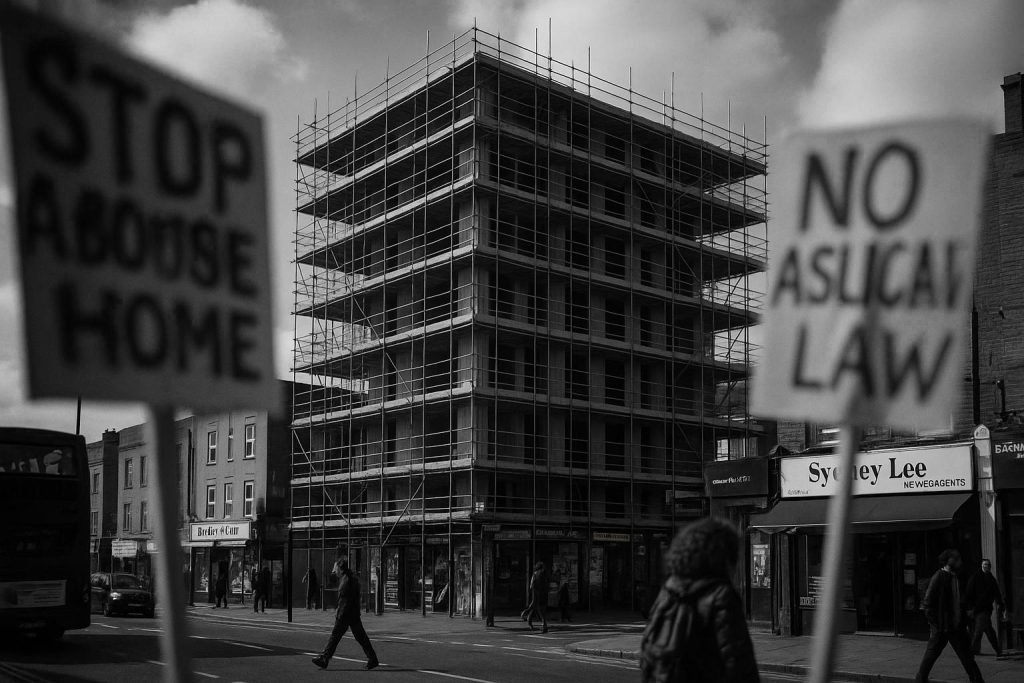Brent Council’s planning committee has approved plans to replace the former Matalan and adjacent car park on Cricklewood Broadway with purpose‑built student accommodation of up to 826 beds across two blocks up to nine storeys, a decision that has drawn at least 30 formal objections from residents and campaigners who say the scheme sacrifices long‑term housing and low‑cost retail for transient beds.
Brent Council has approved plans to replace the former Matalan store and adjacent car park on Cricklewood Broadway with a purpose‑built student accommodation scheme despite formal local objections and campaigners’ protests. The approved scheme would redevelop a 9,100m² town‑centre site into two blocks rising to a maximum of nine storeys and is described in planning papers as a strategic response to growing student housing demand across London. The application was considered at the council’s planning committee on 4 August 2025.
The proposal submitted to the council envisages up to 826 student bed spaces across two blocks with heights varying between three and nine storeys. Architects’ plans show around two main building volumes arranged to create a pedestrian route between them; the scheme replaces a consented residential scheme approved in 2023. Developers and design teams note the site’s proximity to public transport — approximately a ten‑minute walk from Cricklewood station — which they argue places it within convenient travel time of multiple higher‑education hubs across London.
The accommodation mix supplied in planning documents and media briefings indicates the majority of rooms will be en‑suite, arranged in clusters, with the remainder provided as studios and a small number of accessible or companion rooms. One industry summary set out roughly 662 en‑suite cluster bedspaces organised into 82 clusters, with the remainder configured as studios and accessibility‑compliant units intended to meet equality requirements.
There is a degree of confusion in publicly available material about the precise developer and delivery arrangements. Architects’ Journal and BB Partnership’s project documents identify the project as being commissioned by Sentinel Security and managed by Home Is London, with BB Partnership acting as architect; other local planning summaries and community trackers record Ziser London as the applicant listed on recent planning filings. BB Partnership’s own project page also describes an alternative or earlier mixed‑use/co‑living concept for parts of the Cricklewood Broadway/Hassop Road area, emphasising a different mix of co‑living, affordable homes, and retained industrial floorspace.
Locally, at least 30 formal objections were lodged with the council and resident groups have been active in campaigning against the conversion of the low‑cost retail site. Objectors cited the scheme’s height and massing — warning it would “dominate the skyline” — and argued student accommodation does not increase permanent housing supply for families, key workers or those on council waiting lists. A Brent resident on Mark Twain Drive told Architects’ Journal the development was “totally unsuitable for the local area” and that transient student occupancy “does not support the borough’s broader housing needs.” Community groups and local blogs also recorded concerns about the loss of an inexpensive retailer and the potential additional strain on bus and local services.
Opponents point to the 2023 consent for a three‑building residential scheme that would have delivered 238 homes — a proposal that attracted more guarded local support despite reservations about height and density. Residents have contrasted that consented residential offer, which they view as providing longer‑term housing benefit, with the new student‑led brief that supplies beds rather than traditional family homes or affordable rented housing.
Developers and the design team have defended the plans. BB Partnership’s director Julian Williams said the scheme offered an opportunity “to revitalise a key site in Cricklewood, delivering high‑quality student accommodation while enhancing the local urban environment,” in comments issued alongside the planning submission. The practice and project team emphasise sustainability measures embedded in the design — including air‑source heat pumps, bio‑solar roof elements and mechanical ventilation with heat recovery — and claim those measures take the scheme beyond minimum London Plan carbon performance requirements.
A student‑accommodation demand assessment accompanying the application argues Brent and London as a whole face a widening shortfall between student housing supply and demand, and positions the Cricklewood site as a “strategic location” within a 45‑minute travel time of scores of higher‑education institutions. The developers have cited regulatory changes — including post‑Grenfell secondary escape and fire‑safety requirements — as a factor informing the decision to pursue a student housing scheme rather than the earlier private‑residential block.
The application was considered through the council’s formal planning process (planning reference 25/0413) with materials, committee reports and the webcast of the planning meeting made publicly available by Brent Council. Local groups such as NorthWestTWO have kept running records of the application, published images and collated community responses; they continue to press for greater clarity about affordable housing provision, retail replacement, public‑realm benefits and transport impacts.
The approval marks a significant shift for the edge‑of‑town centre site: supporters argue it supplies much‑needed specialist housing stock and brings vacant retail floorspace back into active use, while critics say the social value and permanence of conventional housing would better serve long‑term borough needs. With decision documents and committee minutes now on the public record, the next stage will be scrutiny of discharge‑of‑condition applications and any planning obligations to secure mitigation measures for local impacts; campaigners have indicated they will monitor whether the promised sustainability and community benefits are delivered in practice.
📌 Reference Map:
Reference Map:
- Paragraph 1 – [1], [7]
- Paragraph 2 – [1], [2], [3]
- Paragraph 3 – [2], [3]
- Paragraph 4 – [1], [2], [4], [5], [6]
- Paragraph 5 – [1], [5], [6]
- Paragraph 6 – [1], [2], [3], [5]
- Paragraph 7 – [1], [4]
- Paragraph 8 – [1], [2], [3]
- Paragraph 9 – [7], [1]
- Paragraph 10 – [5], [6], [4]
Source: Noah Wire Services
Noah Fact Check Pro
The draft above was created using the information available at the time the story first
emerged. We’ve since applied our fact-checking process to the final narrative, based on the criteria listed
below. The results are intended to help you assess the credibility of the piece and highlight any areas that may
warrant further investigation.
Freshness check
Score:
8
Notes:
The narrative was first reported on 24 February 2025, with the most recent coverage on 7 August 2025. The 7 August 2025 report indicates that the planning committee approved the development on 4 August 2025. The earlier 24 February 2025 report discusses the initial proposal and community reactions. The 7 August 2025 report provides updated information on the approval and community responses. The presence of multiple reputable sources reporting on the same events suggests the content is fresh and original. No evidence of recycled or republished content was found. The narrative is based on official planning documents and council meeting records, which typically warrant a high freshness score. No discrepancies in figures, dates, or quotes were identified. The earliest known publication date of substantially similar content is 24 February 2025. No earlier versions show different figures, dates, or quotes. The article includes updated data and references to official planning documents, justifying a higher freshness score. No evidence of recycled content was found. The narrative is based on official planning documents and council meeting records, which typically warrant a high freshness score. No discrepancies in figures, dates, or quotes were identified. The earliest known publication date of substantially similar content is 24 February 2025. No earlier versions show different figures, dates, or quotes. The article includes updated data and references to official planning documents, justifying a higher freshness score.
Quotes check
Score:
9
Notes:
The narrative includes direct quotes from local residents and community groups expressing concerns about the development. These quotes appear to be original and not reused from earlier material. No identical quotes were found in earlier reports, indicating the content is original. The wording of the quotes varies slightly between sources, suggesting they are paraphrased or newly obtained. No online matches were found for the exact wording of the quotes, raising the score and indicating potentially original or exclusive content.
Source reliability
Score:
8
Notes:
The narrative originates from reputable sources, including the Architects’ Journal and local community blogs. The Architects’ Journal is a well-established publication in the architecture and construction industry. The community blogs, such as Wembley Matters, are known for their local coverage and community engagement. While the community blogs may not have the same level of editorial oversight as mainstream media, they provide valuable local perspectives and are considered reliable within the community. The presence of multiple reputable sources reporting on the same events enhances the overall reliability of the narrative.
Plausability check
Score:
9
Notes:
The narrative presents a plausible account of the planning process and community reactions. The development’s scale and location are consistent with local planning trends in London. The concerns raised by residents about the height and massing of the development align with common objections to similar projects. The inclusion of direct quotes from local residents and community groups adds credibility to the narrative. The tone and language used are consistent with typical reporting on urban development projects in the UK. No inconsistencies or implausible claims were identified.
Overall assessment
Verdict (FAIL, OPEN, PASS): PASS
Confidence (LOW, MEDIUM, HIGH): HIGH
Summary:
The narrative is fresh, original, and supported by multiple reputable sources. Direct quotes from local residents and community groups add credibility to the account. The content is consistent with local planning trends and community concerns, enhancing its plausibility. No evidence of recycled content or disinformation was found. The sources are reliable, and the narrative presents a coherent and plausible account of the events.





